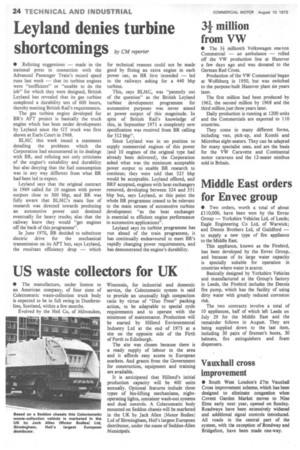Leyland denies turbine shortcomings ,r„.„er
Page 26

If you've noticed an error in this article please click here to report it so we can fix it.
• Refuting suggestions — made in the national press in connection with the Advanced Passenger Train's record speed runs last week — that its turbine engines were "inefficient" or "unable to do the job" for which they were designed, British Leyland has revealed that its gas turbine completed a durability test of 600 hours, thereby meeting British Rail's requirements.
The gas turbine engine developed for BR's APT project is basically the truck engine which has been under development by Leyland since the GT truck was first shown at Earls Court in 1968.
BLMC this week issued a statement detailing the problems which the Corporation had encountered in its dealings with BR, and refuting not only criticisms of the engine's suitability and durability but also denying that the fuel consumption was in any way different from what BR had been led to expect.
Leyland says that the original contract in 1969 called for 10 engines with power outputs close to 300 bhp, and BR was fully aware that BLMC's main line of research was directed towards producing an automotive power unit destined eventually for heavy trucks; also that the railway knew they would "get engines off the back of this programme".
In June 1970, BR decided to substitute electric drive for the mechanical transmission on its APT but, says Leyland, the resultant efficiency drop — which for technical reasons could not be made good by fitting an extra engine in each power car, as BR first intended — led to the railways asking for a 440 bhp turbine.
This, says BLMC, was "patently out of the question" as the British Leyland turbine development programme for automotive purposes was never aimed at power output of this magnitude. In spite of British Rail's knowledge of this, in September 1971 a completely new specification was received from BR calling for 512 bhp".
Since Leyland was in no position to supply commercial engines of this power (and 10 engines of the original type had already been delivered), the Corporation asked what was the minimum acceptable power output to enable BR research to continue; they were told that 325 bhp would be acceptable. Leyland offered, and BRF accepted, engines with heat exchangers removed, developing between 324 and 351 bhp but, says Leyland, at this point the whole BR programme ceased to be relevant to the main stream of automotive turbine development "as the heat exchanger is essential to efficient engine performance in automotive applications".
Leyland says its turbine programme has run ahead of the train programme, it has continually endeavoured to meet BR's rapidly changing power requirements, and has demonstrated the engine's durability.




























































































